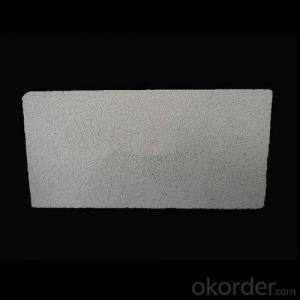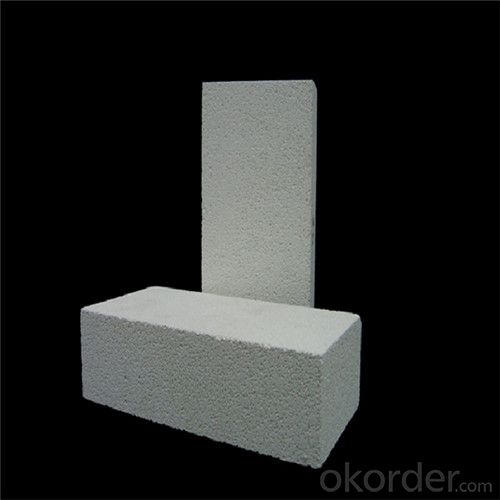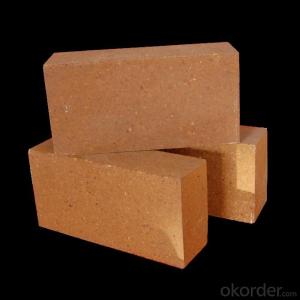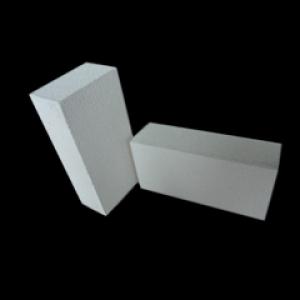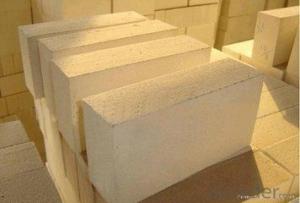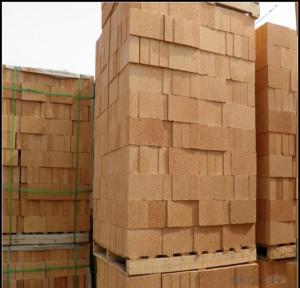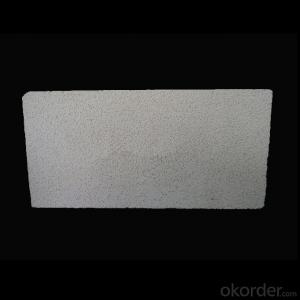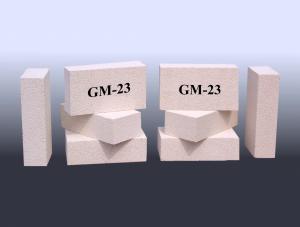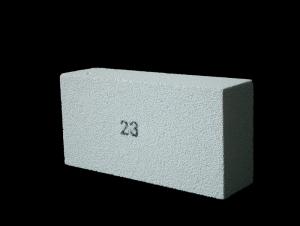Insulating Fire Brick with ISO Certificate for Furnace
- Loading Port:
- Shanghai
- Payment Terms:
- TT OR LC
- Min Order Qty:
- 1 m.t.
- Supply Capability:
- 1000000 m.t./month
OKorder Service Pledge
OKorder Financial Service
You Might Also Like
Introduction of insulating firebrick
Insulating brick is sintered mainly with supper-fine bauxite charlotte and propr additive by a method of EPS ignition loss. Refractory high alumina EPS insulating brick for heating furnace is a kind of insulation refractory product, taking bauxite as main raw material and including not less than 48% of AL2O3.
Characteristics of insulating firebrick
1.High porosity
2.Small volume density
3.Good insulation effect
4.High mechanical intensity
5.Small thermal conductivity
6.Long service life
Application of insulating firebrick
1. Building materials for blast furnace
2. Building materials for hot-blast stove
3. Building materials for coke oven
4. Building materials for steel making furnace
5. For construction material in steel industry
6. For ladle
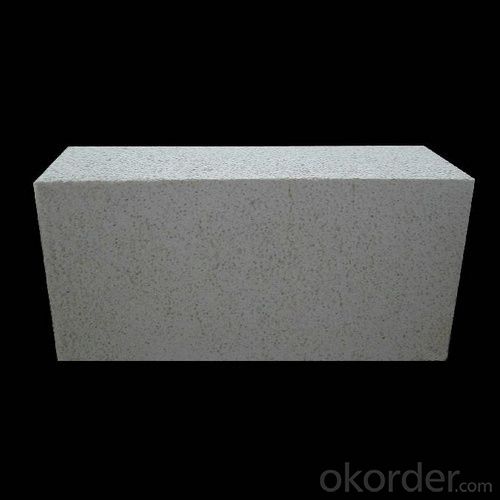
Physical and chemical indexes of insulating firebrick
Brand | Clay insulating bricks | High Alumina insulating bricks | |||||
NG-0.5 | NG-0.6 | NG-0.8 | NG-1.0 | LG-0.6 | LG-0.8 | LG-1.0 | |
Bulk density g/cm3 ≤ | 0.5 | 0.6 | 0.8 | 1 | 0.6 | 0.8 | 1 |
Crushing strength Mpa ≥ | 1.5 | 2 | 2.5 | 3.4 | 1.96 | 2.94 | 4 |
The experimental temperature of linear change ≤2% | 1250 | 1300 | 1350 | 1350 | 1350 | 1400 | 1450 |
Thermal conductivity 350±25(W/m.k) ≤ | 0.18 | 0.25 | 0.35 | 0.5 | 0.25 | 0.032 | 0.45 |
Refractoriness under load | 1160 | 1250 | 1280 | 1300 | 1300 | 1350 | 1380 |
Al2O3 % ≥ | 35 | 40 | 42 | 42 | 50 | 52 | 52 |
Fe2O3 % ≥ | 2.5 | 2.5 | 2 | 2 | 1.8 | 1.6 | 1.5 |
Maximun erice temperature | 1150 | 1200 | 1280 | 1300 | 1300 | 1350 | 1380 |
FAQ
Q2: What`s the lead time for my order?
A2: It depends on customers’ requirements and our production schedule. And usually we need 30-60 days for refractory bricks,10-25 days for unshaped refractory materials and 10-20 days for ceramic fiber blankets.
Q3: Can you offer Door-to-Door delivery?
A3: Yes, but only for some countries such us U.S., UAE, Saudi Arabia, Iran, and Russia, etc.
- Q: Are insulating fire bricks resistant to abrasion or wear?
- Insulating fire bricks possess resistance to abrasion and wear. These bricks are crafted using top-notch refractory materials, like alumina or silica, that exhibit exceptional resistance to abrasion. Through the manufacturing process, the bricks are subjected to high-temperature firing, which enhances their durability and fortifies them. Insulating fire bricks are explicitly engineered to endure the demanding conditions found in high-temperature applications such as furnaces, kilns, and fireplaces. They exhibit high resistance to thermal shock, chemical erosion, and mechanical wear. As a result, they serve as a dependable option for insulating and safeguarding the inner walls of these structures, thereby ensuring long-lasting performance and reducing the need for frequent replacements.
- Q: Can insulating fire bricks be used in crucibles?
- Yes, insulating fire bricks can be used in crucibles. Insulating fire bricks are designed to withstand high temperatures and provide excellent insulation, making them suitable for use in crucibles where extreme heat is required.
- Q: Can insulating fire bricks be used in the construction of refractory linings?
- Indeed, the utilization of insulating fire bricks is possible when constructing refractory linings. These bricks are explicitly engineered to possess exceptional thermal insulation characteristics, rendering them highly suitable for situations necessitating the containment of extreme temperatures. They are frequently employed in the establishment of furnaces, kilns, and other environments that experience elevated heat levels. The insulating attributes of these bricks aid in diminishing heat dissipation, enhancing energy efficiency, and upholding a consistent temperature within the refractory lining. Furthermore, insulating fire bricks are lightweight and effortless to manipulate, thereby constituting a pragmatic selection for the construction of refractory linings.
- Q: Can insulating fire bricks be used in residential fireplaces?
- Yes, insulating fire bricks can be used in residential fireplaces. Insulating fire bricks are designed to withstand high temperatures and provide excellent insulation, making them a suitable choice for fireplace construction. These bricks can help retain heat, increase energy efficiency, and prevent heat loss. They also offer superior protection against thermal shock, which is essential for withstanding the intense heat generated by a fireplace. Additionally, insulating fire bricks are lightweight, easy to handle, and can be easily shaped or cut to fit any fireplace design or size. Overall, using insulating fire bricks in residential fireplaces is a wise choice for homeowners looking to enhance the performance and safety of their fireplace.
- Q: Can insulating fire bricks be used for insulation in industrial chimneys?
- Yes, insulating fire bricks can be used for insulation in industrial chimneys. Insulating fire bricks are designed to withstand high temperatures and provide excellent thermal insulation. Their low thermal conductivity helps to reduce heat loss, increase energy efficiency, and maintain high temperatures inside the chimney. Consequently, they are commonly used in industrial chimneys to enhance insulation and improve overall performance.
- Q: Do insulating fire bricks require curing after installation?
- No, insulating fire bricks do not require curing after installation. They are ready to use once installed.
- Q: Are insulating fire bricks suitable for insulation in power boilers?
- Insulating fire bricks can be suitable for insulation in power boilers depending on the specific requirements and conditions of the boiler. Insulating fire bricks are known for their high temperature resistance and low thermal conductivity, which makes them effective in reducing heat loss and improving energy efficiency in various applications. However, when considering their use in power boilers, several factors need to be taken into account. Firstly, the operating temperature and pressure of the boiler should be considered to ensure that the insulating fire bricks can withstand these conditions without any degradation or failure. Power boilers typically operate at high temperatures and pressures, so it is important to choose insulating fire bricks that have a high temperature rating and can withstand the required pressure. Additionally, the composition and structure of the insulating fire bricks should be considered. Some power boilers may contain corrosive or abrasive substances, which can potentially damage the insulating fire bricks over time. Therefore, it is important to select insulating fire bricks that are resistant to corrosion and abrasion, or to consider additional protective measures such as coatings or linings. Furthermore, the thermal conductivity of the insulating fire bricks should be evaluated. While insulating fire bricks have low thermal conductivity compared to other refractory materials, it is important to ensure that they provide sufficient insulation for the specific requirements of the power boiler. This may involve calculating heat transfer rates and determining the appropriate thickness and density of the insulating fire bricks to achieve the desired insulation performance. Ultimately, the suitability of insulating fire bricks for insulation in power boilers depends on careful consideration of factors such as temperature, pressure, composition, structure, and thermal conductivity. Engaging with experts and conducting proper evaluations and calculations will help determine if insulating fire bricks are a suitable choice for insulation in a particular power boiler application.
- Q: Can insulating fire bricks be used in the construction of ladles?
- Yes, insulating fire bricks can be used in the construction of ladles. Insulating fire bricks are made from lightweight materials that have excellent thermal insulation properties. This makes them ideal for applications where heat needs to be retained or controlled, such as in the construction of ladles used in metal or glass industries. The insulating fire bricks help to reduce heat loss, improve energy efficiency, and maintain the desired temperature within the ladle. Additionally, their lightweight nature makes them easier to handle and install in ladle constructions. Therefore, insulating fire bricks can be a suitable choice for ladle construction, providing the necessary thermal insulation and durability required for these high-temperature applications.
- Q: Can insulating fire bricks be used in the construction of steam generators?
- Indeed, the utilization of insulating fire bricks is possible in the construction of steam generators. Specifically engineered to possess superior thermal insulation properties, these bricks are well-suited for applications necessitating elevated temperatures and thermal stability. Given that steam generators function at high temperatures and necessitate efficient heat transfer, insulation becomes indispensable for preventing heat dissipation and enhancing energy efficiency. By enduring extreme temperatures and offering effective insulation, insulating fire bricks diminish heat losses and enhance the overall effectiveness of steam generators. Furthermore, their lightweight composition facilitates easy handling and installation during the construction process. Therefore, insulating fire bricks represent a fitting choice for the construction of steam generators.
- Q: Can insulating fire bricks be used in aluminum smelting furnaces?
- Yes, insulating fire bricks can be used in aluminum smelting furnaces. Insulating fire bricks are designed to have low thermal conductivity, which helps to minimize heat losses in the furnace. This property makes them suitable for use in high-temperature applications, such as aluminum smelting. In addition, insulating fire bricks have excellent thermal shock resistance, allowing them to withstand rapid temperature changes that occur during the smelting process. Their lightweight nature also makes them easier to handle and install in the furnace. Overall, insulating fire bricks are a viable option for use in aluminum smelting furnaces, helping to improve energy efficiency and reduce operating costs.
Send your message to us
Insulating Fire Brick with ISO Certificate for Furnace
- Loading Port:
- Shanghai
- Payment Terms:
- TT OR LC
- Min Order Qty:
- 1 m.t.
- Supply Capability:
- 1000000 m.t./month
OKorder Service Pledge
OKorder Financial Service
Similar products
Hot products
Hot Searches
Related keywords
